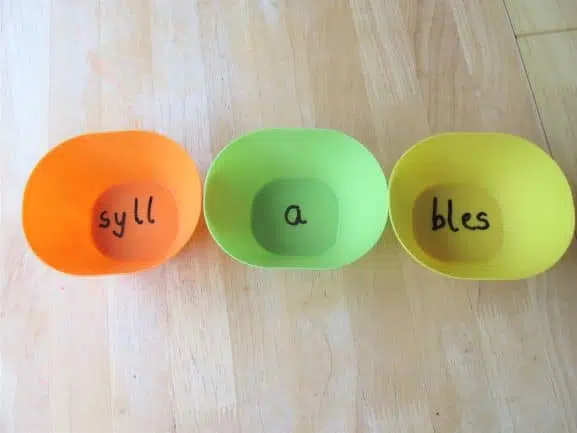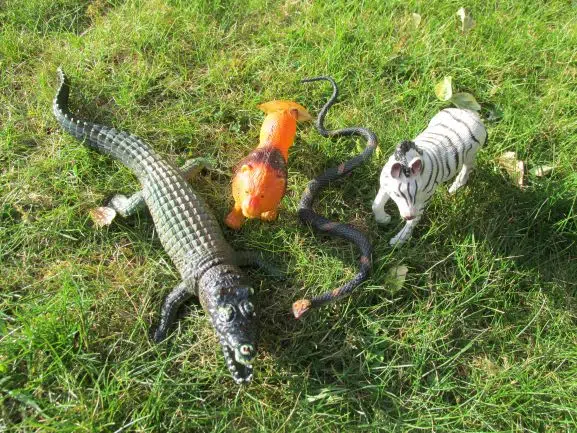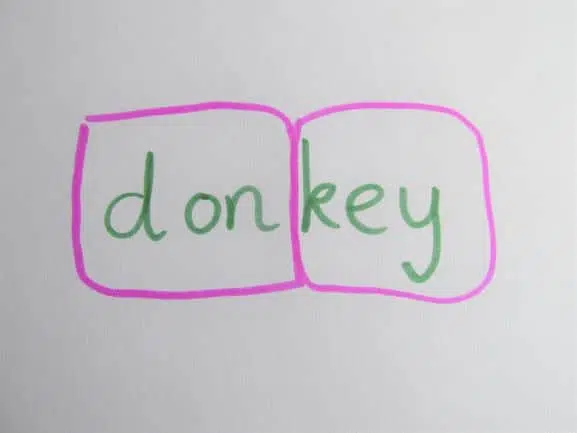Learning syllables is something that can be happening from quite a young age. Many three and four year olds will be able to start the process of learning about syllables in fun games, and this process continues for several years, as children deepen their understanding.
How do you teach syllables?
Begin teaching syllables with chants and songs. Children can hit syllables in words using rhythm sticks or instruments. Use puppets, bags of objects, and songs to grab their attention, and get children experiencing syllables in a range of ways.
That’s the short answer, but there really is a lot more to it than that.
The learning of syllables is a long process. It starts with fun action games, and develops into reading and writing multi-syllabic words.
This article gives you everything you need – how to start, what you need to know, and every possible successful game to try out to teach syllables in a fun and effective way.
This games and activities are targeted at children between the ages of 3 to 6, and can be used just as well by parents as by educators.

1.Use Songs And Chants (With Objects)
The first few games in this article can be done with the children clapping. Alternatively, you could use something like drums, or they could all have a pair of rhythm sticks.
These sticks are my favorite resource for teaching syllables. If you have pairs of claves they will work. You could also use chopsticks, or just some sticks from outside. If you want to know more about what rhythm sticks are and how to use them, then check out this article that I wrote.

For this game you also need some kind of a feely bag and a few jungle animals. There is a chant that you are going to teach the children. It goes like this:
Walking through the jungle
Walking through the jungle
What do I see? What do I see?
All say the chant together, whilst hitting the sticks to the beat of the chant.
Then a child takes one jungle animal out of the bag. The idea now is to hit the syllables in the name of the animal, and then count the syllables as well.
For example, a cheetah would be ‘chee-tah! 1-2!’ Repeat this a few times, e.g. ‘Chee-tah! 1-2! Chee-tah! 1-2! Chee-tah! 1-2!’ Repetition in games like this is crucial for them to start to understand the skill.
Repeat the process with different animals. It’s good if you have a selection of animals that have different numbers of syllables in their names. For example, you could have a snake (1), a tiger (2), a crocodile (3), and a hippopotamus (5).

2.Hit The Puppet Words!
Puppets really get the attention of the vast majority of children! They work almost like magic in some cases.
In this game, the puppet is going to say a word, and we all then copy the word, whilst hitting the syllables with rhythm sticks, drums or claps.
It’s nice to have a theme. For example, you could ask the puppet what it likes to eat.
It might say ‘a-pple! 1-2!’ (All copy and hit). ‘Ba-na-na.’ ‘Cake.’
One again repeat each word a few times so the children really get the hang of it.
3.Magic Box!
Anything with magic in is definitely a winner!
All you need for this is some kind of box that looks at least slightly magical. It could be an old chest, or a picnic hamper. Even an old suitcase would be fine.
Before the children are around, put a few objects into it (preferably ones that have a variety of syllables in their names).
Then when they are watching, you are all going to do a spell. Wiggle your magic fingers at the box and chant:
Magic box, magic box,
Say a spell,
It unlocks!
Open the box, and take out an object. Whatever it is, you all hit the word, and count the syllables.
The magic is mainly to get them interested, looking and excited to see what’s happening. A bit of drama is the answer for almost all early phonics games.
4.Nursery Rhymes
One of the best ways of getting children beginning to understand about syllables is to use nursery rhymes.
This is the step before all the other activities in this list, but it is probably the most important!
All nursery rhymes are good for starting to understand syllables.
However, just to pick one, let’s go for The Wheels On The Bus. This has lots of great sound effects in that have different numbers of syllables. For example, the wipers go ‘swish!’ (1), the adults go ‘chatter’ (2), the children go ‘up-and-down’ (3).
All these sounds have actions to go with them as well, so you are physically acting out the number of syllables.
Children at this point will have no idea what the word ‘syllables’ means, but they will be starting to understand the concept.
5.Use Instruments
What fun it is to whack the syllables in words using instruments!
Just give out loads of instruments in this one, and then give the children some sort of word. Hit the word together, like a ‘syllable band.’ Then count the syllables.

For example, go ‘cho-co-late! 1-2-3! Cho-co-late! 1-2-3!’
Children never get bored when they are hitting instruments, so this lengthens the amount of time you can do the activity for.
6.Story With Sound Effects
This is another nice simple activity for starting the process of syllable learning.
Again this works really well with rhythm sticks, but you could use clapping.
Basically, you make up a story! It could be about anything, but it is important that you use lots of sound effects in it. The children hit and say the sound effects!
For example, the story could go something like ‘One day a big bear went stamping through the woods – stamp, stamp, stamp. It met it’s friend the cuckoo. It was saying ‘cuckoo, cuckoo, cuckoo.’ Suddenly a witch flew down going cackle, cackle, cackle.’
Activities like this are great for exploring the rhythm in spoken language. Children are experiencing syllables in a fun way, and that is the best foundation for later learning what they are.
7.Books With Sound Effects
In a similar way, any book you can find with sound effects in is great for this same strategy.
One fantastic example is the book Peace At Last, by Jill Murphy.
In this book, Mr Bear is trying to get to sleep in his house, but there are all sorts of awful noises going on! The tap is going ‘drip!’ (1 syllable) The clock is going ‘tick-tock!’ (2) and ‘cuckoo’.(2)
This is a great book for the children to all chant the sound effects together. You could clap or hit the syllables at the same time to really emphasize the point.
8.Jumping
Making early phonics as multisensory as possible is definitely the way to go!
If you can get children moving, then you can get them learning.
Jumping the syllables is an excellent way to learn what syllables are all about. Just give the children a word, and then jump it. For example, ‘coconut’ would be three jumps – ‘co-co-nut’. ‘Mango’ would be two – ‘man-go.’
You could try other types of movement as well. The children could hop! They could point up high. Be as imaginative as you can.
9.Hit The Words Theme
This one is another game that requires clapping, rhythm sticks or drums.
It is good if you pick some kind of theme, and say words that relate to that theme. Start easy, but if they are doing really well then you can always make it harder.
For example, if the theme was superheroes, you just say the names of different superheroes, and the children clap or hit the name. Such as:
Hulk!
Hulk!
Captain America
Cap-tain A-me-ri-ca
Spiderman
Spi-der-man
Batman
Bat-man
Other themes you can try are ones like vehicles, food, jungle animals, dinosaurs – anything they are interested in then go with that.
10.Different Syllable Challenge
This one is quite a bit harder! Start with the other games first, but this is very much a next step.
What you do, is select three objects that each have a different number of syllables in their names. For example, it could be a ‘truck’, ‘lorry’, and ‘bicycle.’
Show the children the objects, and practise hitting the words with sticks, or clapping.
Then you hit one of the words with something like a drum, but you don’t say anything. For example, you do two hits of the drum.
The children have to work out which object’s name you were hitting, and then point at that object. Then repeat with the other objects, e.g. one hit for ‘truck’, and three for ‘bicycle.’ This really gets them thinking!
11.Dance The Words
Who can resist a bit of dance!
What you do for this is get the children on their feet, and show them some sort of simple dance move. It could be arms up then down, for example.
Give them a word, like ‘elephant’. What they do is dance the word using the dance move, one move for each syllable – ‘e-le-phant!’ Repeat a few times for each word.
Get them to invent their own dance moves. This gives them a bit of ownership which they really value.
Dancing can be brilliant for many early phonics skills, suh as oral segmenting.
12.Draw The Words
This is an early-writing activity.
This can be done before children are able to read or write.
What you do is to draw a word in dots, where there is one dots per syllable. For example, the word ‘cucumber’ would be ‘• • •’. The word ‘bedroom’ would be ‘• •’.

This is potentially an excellent early mark-making activity that they can have a go of. It is also a great early reading game, and is getting them used to responding to symbols that represent sounds.
13.Draw Sentences As Syllable Dots
The next step to the last game is to draw a whole sentence in dots! Again this is an early reading and writing strategy, and you can try this before the children have learn to read and write words.
What you do is to take a simple sentence or phrase and draw it in dots. Then get the children to clap or hit the syllables.
For example, the phrase ‘brush your teeth’ could be drawn ‘• • •’. The phrase ‘go on the bus’ would be ‘• • • •’.
This strategy works best for one syllable words in sentences.
I would not go beyond this before they start learning to read and write.
14. Written Sentences
This is a version of the last game, but extended for children that are able to read.
Get a simple sentence, and clap or hit the syllables. For this you can also use words with more than one syllable.
So, for example, the sentence could be ‘I saw a tractor.’ Get them all to hit the sentence – 1,2,3,4,5.
This is good for learning about syllables, but also excellent for early sentence writing as well. By breaking the sentence up into words and syllables, the children visualize it, and understand better how language is broken up into units.
15.Draw Boxes Around Words
This is another good one for when the children are able to read.
You quite simply get a list of words that have different numbers of syllables in. It could be the words – ‘tractor,’ ‘train’, ‘scooter’, and ‘helicopter’.
The children quite simply have to draw a circle or a box around each syllable in the word.
This is quite a formal way of practising and assessing the skill.

16.Whack The Dough!
This is a really good one for active children, and those that like to learn things in a physical way.
What you do is to have a ball of dough each. It is best to play this game on a table top.
Decide what word you are going to ‘whack’. It could be the word ‘crocodile’ for example.
Get the children to split their dough up into three balls and put them in a line in front of them. Then you are going to split the word up into its syllables as you whack the dough, e.g. ‘cro’ (whack) ‘co’ (whack) ‘dile’. Repeat the process a few times with each word.
If they can think how many syllables are in a word themselves then that’s great. If not, just tell them how many balls to make, and it’s good for them to experience the syllables in a fun way.
This dough whacking game can also be adapted for other skills like one to one counting. To read my definitive guide to what one to one correspondence is and how to teach it, then go here.
17.Use Different Voices!
This is an excellent strategy to ‘hook’ the interest of some children that may not be that excited by early phonics games.
It is also a great one for lots of boys (though girls will like it too).
What you do is pick some voices that the children could try out. Some example voices could be things like ghosts, aliens, robots, dragons, mice – anything like that will work well.
Give the children a voice, and give them a word to say. For example, the voice could be ‘like a ghost’, and the word is ‘computer’. Say ‘com-pu-ter!’ in your best ghost voice. Then repeat!
It’s as simple as that. They love exploring the sounds of their own voices! Hours of fun.
Top Tips For Learning Syllables
• Start with songs and nursery rhymes
• Use objects of things they are interested in and hit or clap the syllables
• Use clapping, drums or rhythm sticks (or anything else that will do a similar job)
• Children need to experience what a syllable is in a range of ways before they need to understand the terminology
• Make it active, multisensory and fun
If you have found this article useful, then I would recommend trying out one of these:
